warning FIAT TALENTO 2020 Owner handbook (in English)
[x] Cancel search | Manufacturer: FIAT, Model Year: 2020, Model line: TALENTO, Model: FIAT TALENTO 2020Pages: 236, PDF Size: 4.86 MB
Page 60 of 236
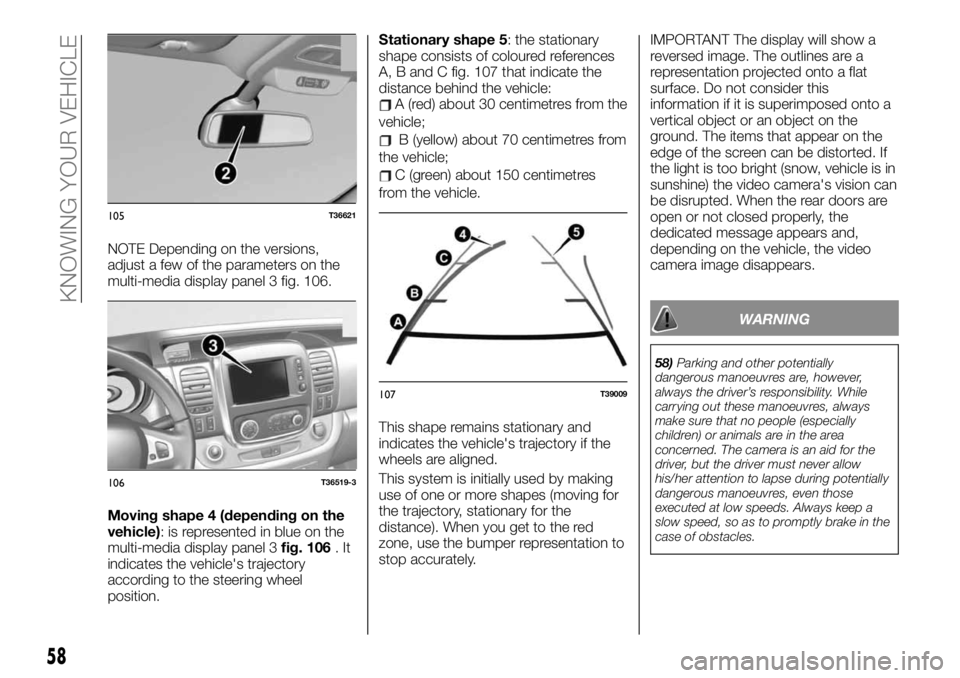
NOTE Depending on the versions,
adjust a few of the parameters on the
multi-media display panel 3 fig. 106.
Moving shape 4 (depending on the
vehicle): is represented in blue on the
multi-media display panel 3fig. 106.It
indicates the vehicle's trajectory
according to the steering wheel
position.Stationary shape 5: the stationary
shape consists of coloured references
A, B and C fig. 107 that indicate the
distance behind the vehicle:
A (red) about 30 centimetres from the
vehicle;
B (yellow) about 70 centimetres from
the vehicle;
C (green) about 150 centimetres
from the vehicle.
This shape remains stationary and
indicates the vehicle's trajectory if the
wheels are aligned.
This system is initially used by making
use of one or more shapes (moving for
the trajectory, stationary for the
distance). When you get to the red
zone, use the bumper representation to
stop accurately.IMPORTANT The display will show a
reversed image. The outlines are a
representation projected onto a flat
surface. Do not consider this
information if it is superimposed onto a
vertical object or an object on the
ground. The items that appear on the
edge of the screen can be distorted. If
the light is too bright (snow, vehicle is in
sunshine) the video camera's vision can
be disrupted. When the rear doors are
open or not closed properly, the
dedicated message appears and,
depending on the vehicle, the video
camera image disappears.
WARNING
58)Parking and other potentially
dangerous manoeuvres are, however,
always the driver’s responsibility. While
carrying out these manoeuvres, always
make sure that no people (especially
children) or animals are in the area
concerned. The camera is an aid for the
driver, but the driver must never allow
his/her attention to lapse during potentially
dangerous manoeuvres, even those
executed at low speeds. Always keep a
slow speed, so as to promptly brake in the
case of obstacles.
105T36621
106T36519-3
107T39009
58
KNOWING YOUR VEHICLE
Page 62 of 236
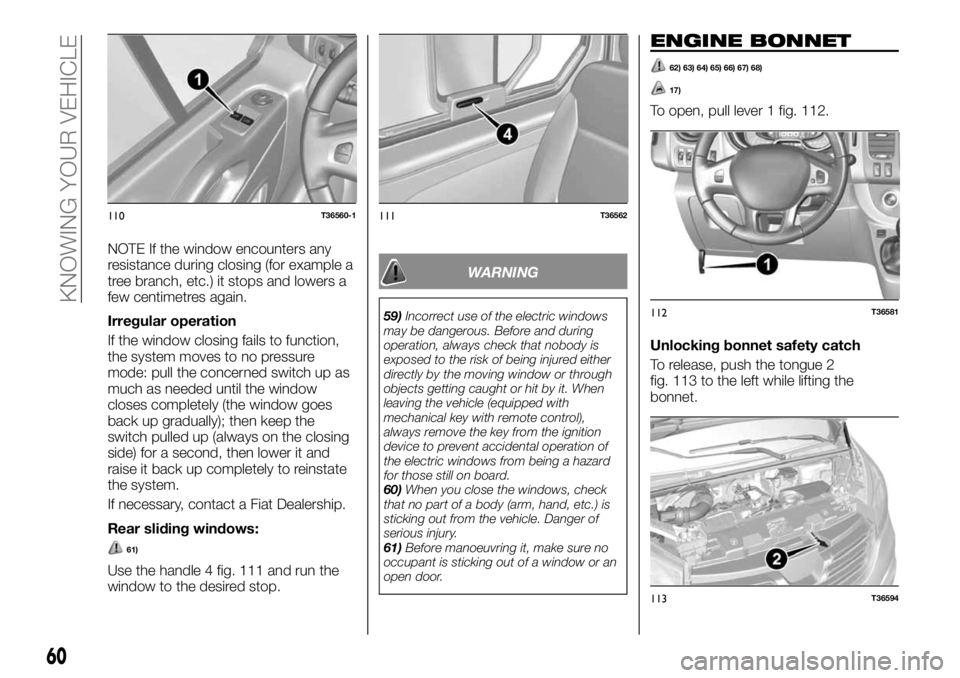
NOTE If the window encounters any
resistance during closing (for example a
tree branch, etc.) it stops and lowers a
few centimetres again.
Irregular operation
If the window closing fails to function,
the system moves to no pressure
mode: pull the concerned switch up as
much as needed until the window
closes completely (the window goes
back up gradually); then keep the
switch pulled up (always on the closing
side) for a second, then lower it and
raise it back up completely to reinstate
the system.
If necessary, contact a Fiat Dealership.
Rear sliding windows:
61)
Use the handle 4 fig. 111 and run the
window to the desired stop.
WARNING
59)Incorrect use of the electric windows
may be dangerous. Before and during
operation, always check that nobody is
exposed to the risk of being injured either
directly by the moving window or through
objects getting caught or hit by it. When
leaving the vehicle (equipped with
mechanical key with remote control),
always remove the key from the ignition
device to prevent accidental operation of
the electric windows from being a hazard
for those still on board.
60)When you close the windows, check
that no part of a body (arm, hand, etc.) is
sticking out from the vehicle. Danger of
serious injury.
61)Before manoeuvring it, make sure no
occupant is sticking out of a window or an
open door.
ENGINE BONNET
62) 63) 64) 65) 66) 67) 68)
17)
To open, pull lever 1 fig. 112.
Unlocking bonnet safety catch
To release, push the tongue 2
fig. 113 to the left while lifting the
bonnet.
110T36560-1111T36562
112T36581
113T36594
60
KNOWING YOUR VEHICLE
Page 63 of 236
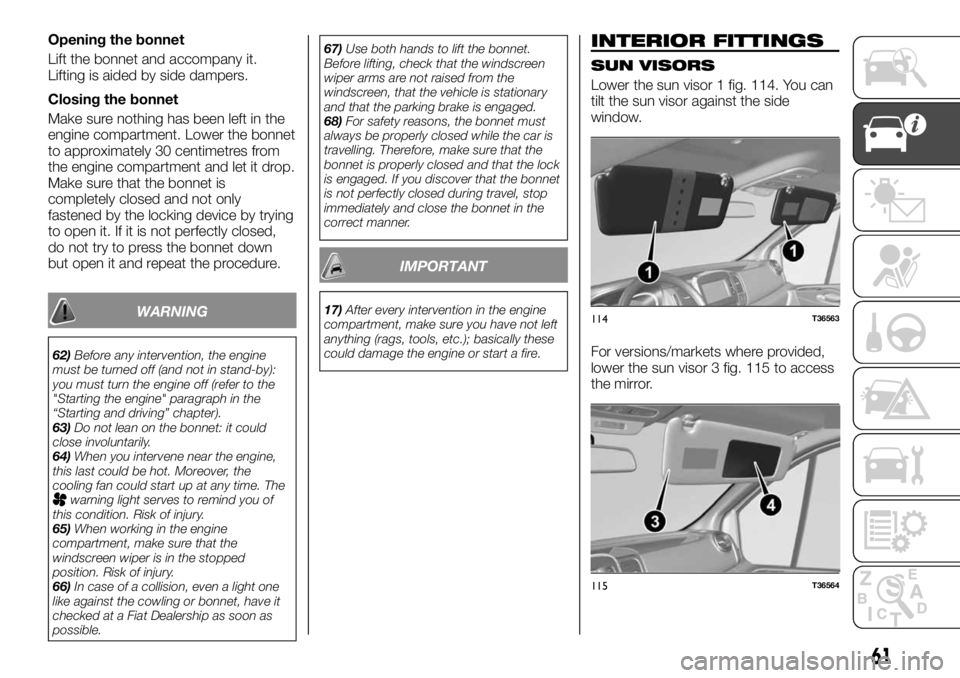
Opening the bonnet
Lift the bonnet and accompany it.
Lifting is aided by side dampers.
Closing the bonnet
Make sure nothing has been left in the
engine compartment. Lower the bonnet
to approximately 30 centimetres from
the engine compartment and let it drop.
Make sure that the bonnet is
completely closed and not only
fastened by the locking device by trying
to open it. If it is not perfectly closed,
do not try to press the bonnet down
but open it and repeat the procedure.
WARNING
62)Before any intervention, the engine
must be turned off (and not in stand-by):
you must turn the engine off (refer to the
"Starting the engine" paragraph in the
“Starting and driving” chapter).
63)Do not lean on the bonnet: it could
close involuntarily.
64)When you intervene near the engine,
this last could be hot. Moreover, the
cooling fan could start up at any time. The
warning light serves to remind you of
this condition. Risk of injury.
65)When working in the engine
compartment, make sure that the
windscreen wiper is in the stopped
position. Risk of injury.
66)In case of a collision, even a light one
like against the cowling or bonnet, have it
checked at a Fiat Dealership as soon as
possible.67)Use both hands to lift the bonnet.
Before lifting, check that the windscreen
wiper arms are not raised from the
windscreen, that the vehicle is stationary
and that the parking brake is engaged.
68)For safety reasons, the bonnet must
always be properly closed while the car is
travelling. Therefore, make sure that the
bonnet is properly closed and that the lock
is engaged. If you discover that the bonnet
is not perfectly closed during travel, stop
immediately and close the bonnet in the
correct manner.
IMPORTANT
17)After every intervention in the engine
compartment, make sure you have not left
anything (rags, tools, etc.); basically these
could damage the engine or start a fire.
INTERIOR FITTINGS
SUN VISORS
Lower the sun visor 1 fig. 114. You can
tilt the sun visor against the side
window.
For versions/markets where provided,
lower the sun visor 3 fig. 115 to access
the mirror.
114T36563
115T36564
61
Page 69 of 236
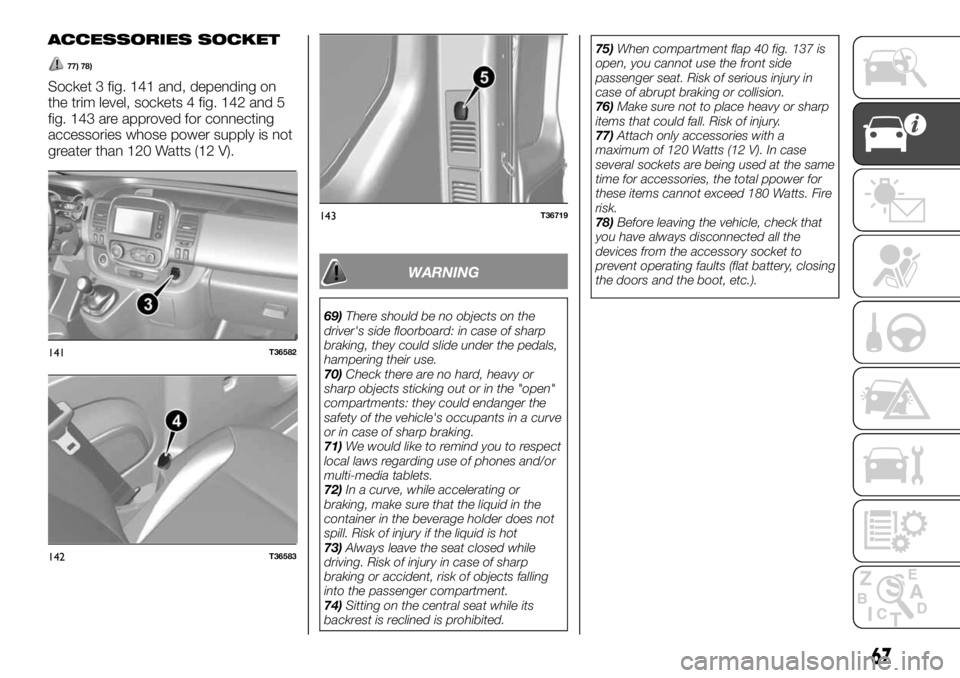
ACCESSORIES SOCKET
77) 78)
Socket 3 fig. 141 and, depending on
the trim level, sockets 4 fig. 142 and 5
fig. 143 are approved for connecting
accessories whose power supply is not
greater than 120 Watts (12 V).
WARNING
69)There should be no objects on the
driver's side floorboard: in case of sharp
braking, they could slide under the pedals,
hampering their use.
70)Check there are no hard, heavy or
sharp objects sticking out or in the "open"
compartments: they could endanger the
safety of the vehicle's occupants in a curve
or in case of sharp braking.
71)We would like to remind you to respect
local laws regarding use of phones and/or
multi-media tablets.
72)In a curve, while accelerating or
braking, make sure that the liquid in the
container in the beverage holder does not
spill. Risk of injury if the liquid is hot
73)Always leave the seat closed while
driving. Risk of injury in case of sharp
braking or accident, risk of objects falling
into the passenger compartment.
74)Sitting on the central seat while its
backrest is reclined is prohibited.75)When compartment flap 40 fig. 137 is
open, you cannot use the front side
passenger seat. Risk of serious injury in
case of abrupt braking or collision.
76)Make sure not to place heavy or sharp
items that could fall. Risk of injury.
77)Attach only accessories with a
maximum of 120 Watts (12 V). In case
several sockets are being used at the same
time for accessories, the total ppower for
these items cannot exceed 180 Watts. Fire
risk.
78)Before leaving the vehicle, check that
you have always disconnected all the
devices from the accessory socket to
prevent operating faults (flat battery, closing
the doors and the boot, etc.).
141T36582
142T36583
143T36719
67
Page 71 of 236

BAGGAGE COVER
79)
The luggage cover consists of one or
two rigid parts.
There are two possible positions:
position A high fig. 147;
position B low fig. 149.
Depending on the versions, you can lift
up part 1 fig. 148 to the vertical position
to make luggage loading easier.
WARNING
79)Do not put anything, especially if it is
heavy or blunt, on the boot. In case you
brake suddenly or have an accident, you
risk the safety of the vehicle's occupants.
CRUISE CONTROL
(constant speed
regulator)
80) 81)
This is an electronically controlled
driving assistance device that allows the
desired vehicle speed to be maintained,
without having to press the accelerator
pedal.
This device can be used at a speed
above 30 km/h on long stretches of dry,
straight roads with few variations (e.g.
motorways).
Commands (fig. 150 and fig. 151 )
147T36651
148T36652
149T36653
150T36543
69
Page 72 of 236
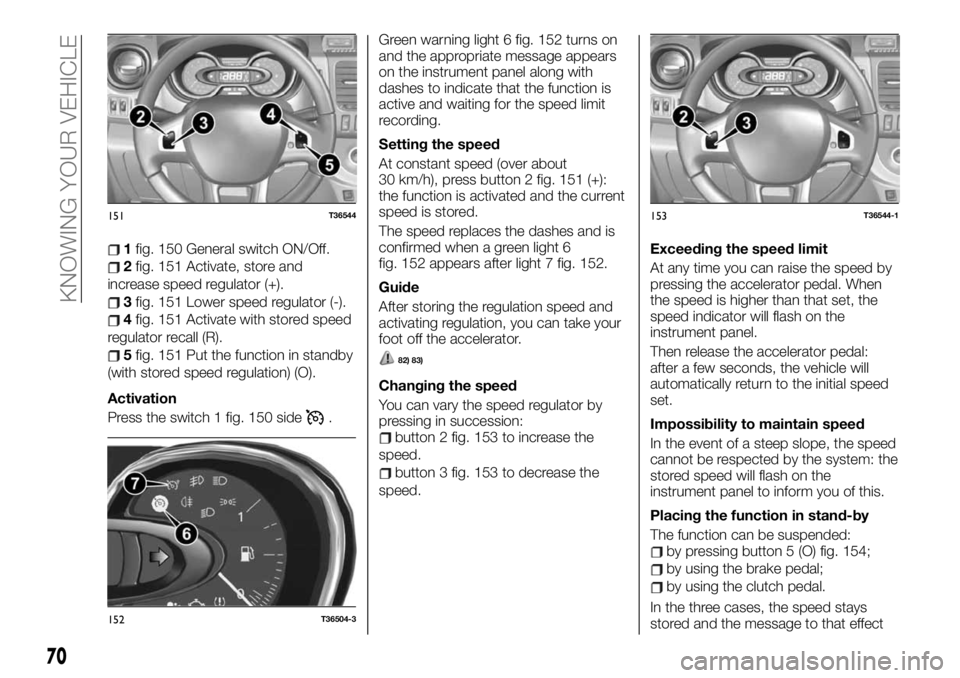
1fig. 150 General switch ON/Off.
2fig. 151 Activate, store and
increase speed regulator (+).
3fig. 151 Lower speed regulator (-).
4fig. 151 Activate with stored speed
regulator recall (R).
5fig. 151 Put the function in standby
(with stored speed regulation) (O).
Activation
Press the switch 1 fig. 150 side
.Green warning light 6 fig. 152 turns on
and the appropriate message appears
on the instrument panel along with
dashes to indicate that the function is
active and waiting for the speed limit
recording.
Setting the speed
At constant speed (over about
30 km/h), press button 2 fig. 151 (+):
the function is activated and the current
speed is stored.
The speed replaces the dashes and is
confirmed when a green light 6
fig. 152 appears after light 7 fig. 152.
Guide
After storing the regulation speed and
activating regulation, you can take your
foot off the accelerator.
82) 83)
Changing the speed
You can vary the speed regulator by
pressing in succession:
button 2 fig. 153 to increase the
speed.
button 3 fig. 153 to decrease the
speed.Exceeding the speed limit
At any time you can raise the speed by
pressing the accelerator pedal. When
the speed is higher than that set, the
speed indicator will flash on the
instrument panel.
Then release the accelerator pedal:
after a few seconds, the vehicle will
automatically return to the initial speed
set.
Impossibility to maintain speed
In the event of a steep slope, the speed
cannot be respected by the system: the
stored speed will flash on the
instrument panel to inform you of this.
Placing the function in stand-by
The function can be suspended:
by pressing button 5 (O) fig. 154;
by using the brake pedal;
by using the clutch pedal.
In the three cases, the speed stays
stored and the message to that effect
151T36544
152T36504-3
153T36544-1
70
KNOWING YOUR VEHICLE
Page 73 of 236
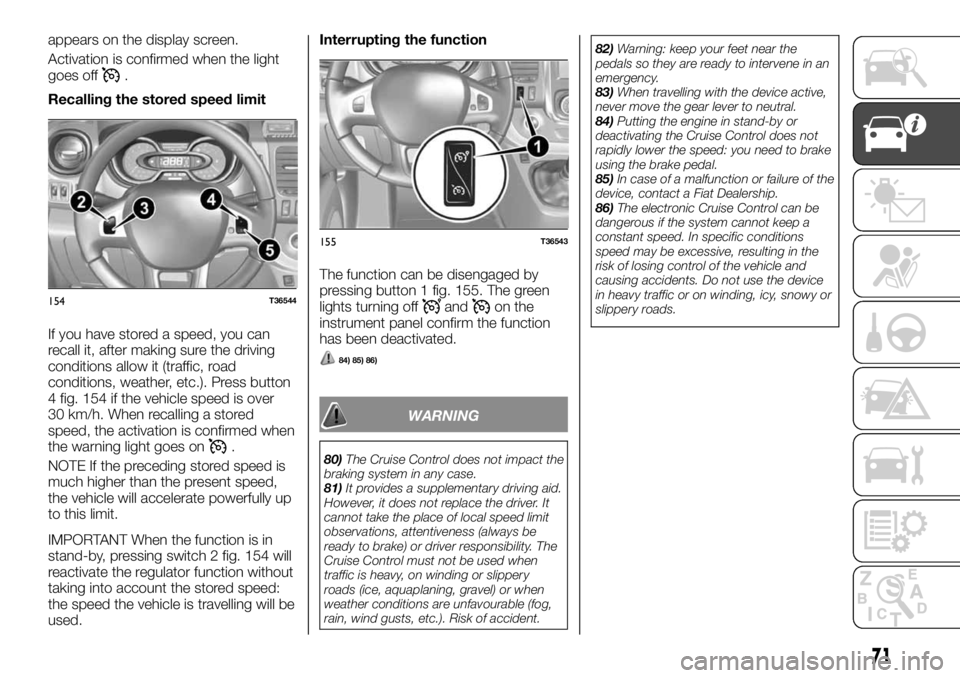
appears on the display screen.
Activation is confirmed when the light
goes off
.
Recalling the stored speed limit
If you have stored a speed, you can
recall it, after making sure the driving
conditions allow it (traffic, road
conditions, weather, etc.). Press button
4 fig. 154 if the vehicle speed is over
30 km/h. When recalling a stored
speed, the activation is confirmed when
the warning light goes on
.
NOTE If the preceding stored speed is
much higher than the present speed,
the vehicle will accelerate powerfully up
to this limit.
IMPORTANT When the function is in
stand-by, pressing switch 2 fig. 154 will
reactivate the regulator function without
taking into account the stored speed:
the speed the vehicle is travelling will be
used.Interrupting the function
The function can be disengaged by
pressing button 1 fig. 155. The green
lights turning off
andon the
instrument panel confirm the function
has been deactivated.
84) 85) 86)
WARNING
80)The Cruise Control does not impact the
braking system in any case.
81)It provides a supplementary driving aid.
However, it does not replace the driver. It
cannot take the place of local speed limit
observations, attentiveness (always be
ready to brake) or driver responsibility. The
Cruise Control must not be used when
traffic is heavy, on winding or slippery
roads (ice, aquaplaning, gravel) or when
weather conditions are unfavourable (fog,
rain, wind gusts, etc.). Risk of accident.82)Warning: keep your feet near the
pedals so they are ready to intervene in an
emergency.
83)When travelling with the device active,
never move the gear lever to neutral.
84)Putting the engine in stand-by or
deactivating the Cruise Control does not
rapidly lower the speed: you need to brake
using the brake pedal.
85)In case of a malfunction or failure of the
device, contact a Fiat Dealership.
86)The electronic Cruise Control can be
dangerous if the system cannot keep a
constant speed. In specific conditions
speed may be excessive, resulting in the
risk of losing control of the vehicle and
causing accidents. Do not use the device
in heavy traffic or on winding, icy, snowy or
slippery roads.
154T36544
155T36543
71
Page 74 of 236
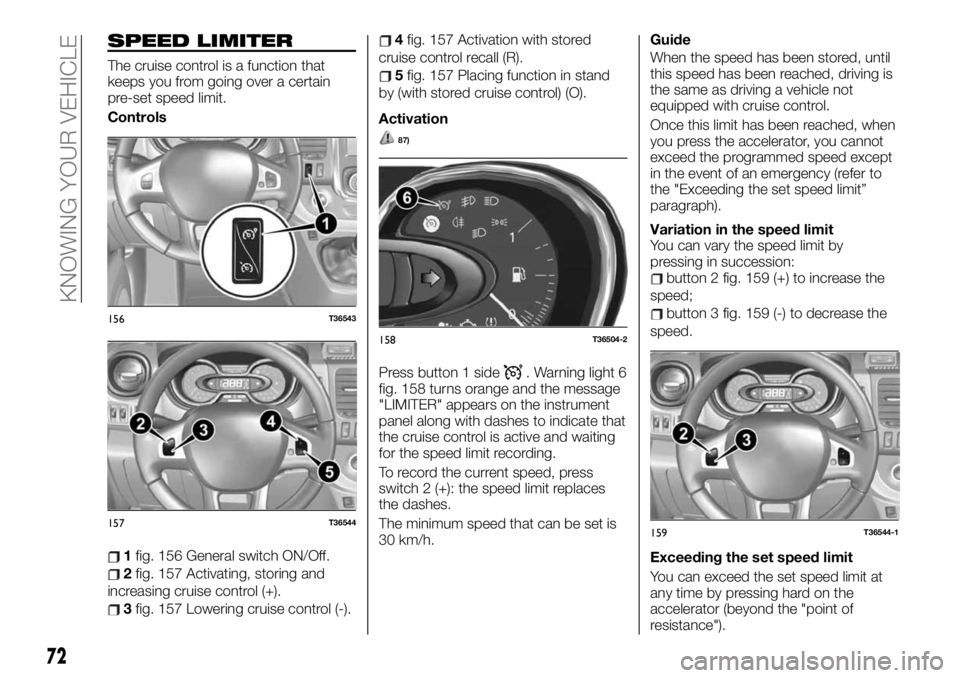
SPEED LIMITER
The cruise control is a function that
keeps you from going over a certain
pre-set speed limit.
Controls
1fig. 156 General switch ON/Off.
2fig. 157 Activating, storing and
increasing cruise control (+).
3fig. 157 Lowering cruise control (-).
4fig. 157 Activation with stored
cruise control recall (R).
5fig. 157 Placing function in stand
by (with stored cruise control) (O).
Activation
87)
Press button 1 side. Warning light 6
fig. 158 turns orange and the message
"LIMITER" appears on the instrument
panel along with dashes to indicate that
the cruise control is active and waiting
for the speed limit recording.
To record the current speed, press
switch 2 (+): the speed limit replaces
the dashes.
The minimum speed that can be set is
30 km/h.Guide
When the speed has been stored, until
this speed has been reached, driving is
the same as driving a vehicle not
equipped with cruise control.
Once this limit has been reached, when
you press the accelerator, you cannot
exceed the programmed speed except
in the event of an emergency (refer to
the "Exceeding the set speed limit”
paragraph).
Variation in the speed limit
You can vary the speed limit by
pressing in succession:
button 2 fig. 159 (+) to increase the
speed;
button 3 fig. 159 (-) to decrease the
speed.
Exceeding the set speed limit
You can exceed the set speed limit at
any time by pressing hard on the
accelerator (beyond the "point of
resistance").156T36543
157T36544
158T36504-2
159T36544-1
72
KNOWING YOUR VEHICLE
Page 75 of 236
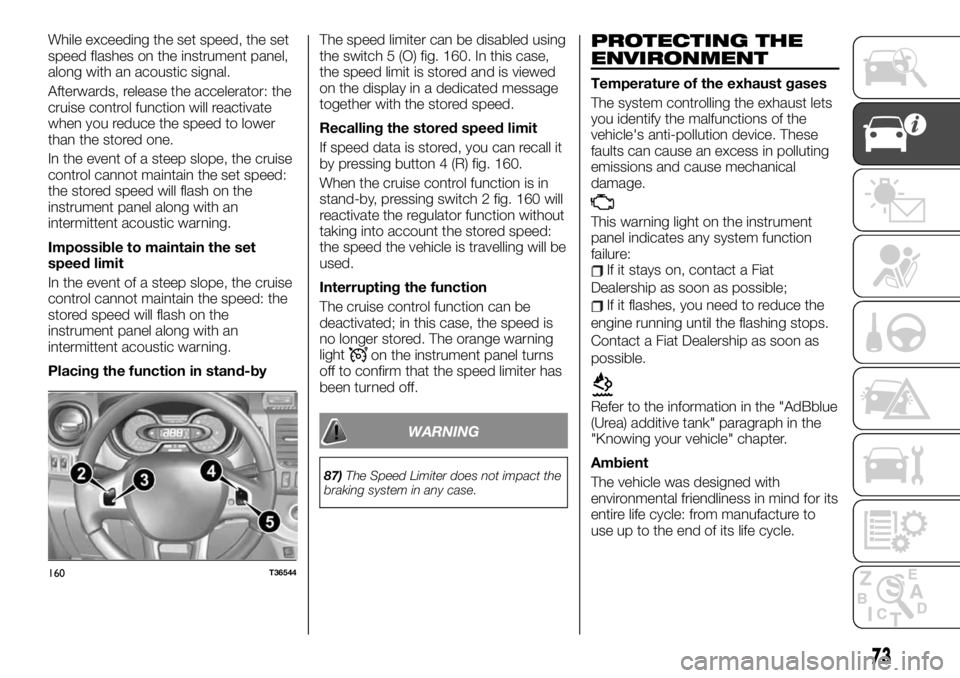
While exceeding the set speed, the set
speed flashes on the instrument panel,
along with an acoustic signal.
Afterwards, release the accelerator: the
cruise control function will reactivate
when you reduce the speed to lower
than the stored one.
In the event of a steep slope, the cruise
control cannot maintain the set speed:
the stored speed will flash on the
instrument panel along with an
intermittent acoustic warning.
Impossible to maintain the set
speed limit
In the event of a steep slope, the cruise
control cannot maintain the speed: the
stored speed will flash on the
instrument panel along with an
intermittent acoustic warning.
Placing the function in stand-byThe speed limiter can be disabled using
the switch 5 (O) fig. 160. In this case,
the speed limit is stored and is viewed
on the display in a dedicated message
together with the stored speed.
Recalling the stored speed limit
If speed data is stored, you can recall it
by pressing button 4 (R) fig. 160.
When the cruise control function is in
stand-by, pressing switch 2 fig. 160 will
reactivate the regulator function without
taking into account the stored speed:
the speed the vehicle is travelling will be
used.
Interrupting the function
The cruise control function can be
deactivated; in this case, the speed is
no longer stored. The orange warning
light
on the instrument panel turns
off to confirm that the speed limiter has
been turned off.
WARNING
87)The Speed Limiter does not impact the
braking system in any case.
PROTECTING THE
ENVIRONMENT
Temperature of the exhaust gases
The system controlling the exhaust lets
you identify the malfunctions of the
vehicle's anti-pollution device. These
faults can cause an excess in polluting
emissions and cause mechanical
damage.
This warning light on the instrument
panel indicates any system function
failure:
If it stays on, contact a Fiat
Dealership as soon as possible;
If it flashes, you need to reduce the
engine running until the flashing stops.
Contact a Fiat Dealership as soon as
possible.
Refer to the information in the "AdBblue
(Urea) additive tank" paragraph in the
"Knowing your vehicle" chapter.
Ambient
The vehicle was designed with
environmental friendliness in mind for its
entire life cycle: from manufacture to
use up to the end of its life cycle.
160T36544
73
Page 76 of 236
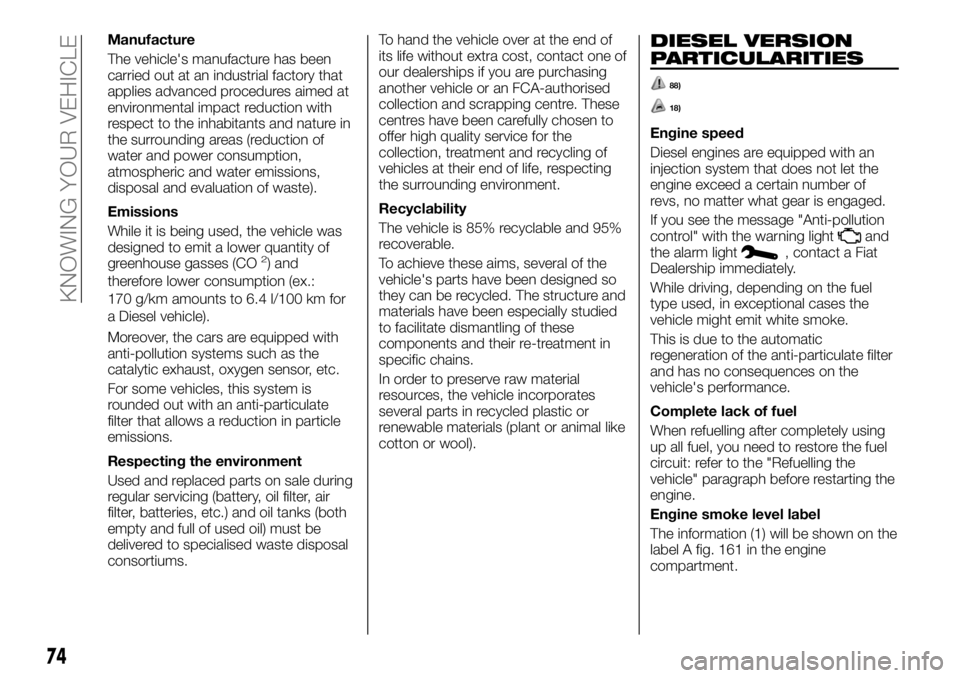
Manufacture
The vehicle's manufacture has been
carried out at an industrial factory that
applies advanced procedures aimed at
environmental impact reduction with
respect to the inhabitants and nature in
the surrounding areas (reduction of
water and power consumption,
atmospheric and water emissions,
disposal and evaluation of waste).
Emissions
While it is being used, the vehicle was
designed to emit a lower quantity of
greenhouse gasses (CO
2) and
therefore lower consumption (ex.:
170 g/km amounts to 6.4 l/100 km for
a Diesel vehicle).
Moreover, the cars are equipped with
anti-pollution systems such as the
catalytic exhaust, oxygen sensor, etc.
For some vehicles, this system is
rounded out with an anti-particulate
filter that allows a reduction in particle
emissions.
Respecting the environment
Used and replaced parts on sale during
regular servicing (battery, oil filter, air
filter, batteries, etc.) and oil tanks (both
empty and full of used oil) must be
delivered to specialised waste disposal
consortiums.To hand the vehicle over at the end of
its life without extra cost, contact one of
our dealerships if you are purchasing
another vehicle or an FCA-authorised
collection and scrapping centre. These
centres have been carefully chosen to
offer high quality service for the
collection, treatment and recycling of
vehicles at their end of life, respecting
the surrounding environment.
Recyclability
The vehicle is 85% recyclable and 95%
recoverable.
To achieve these aims, several of the
vehicle's parts have been designed so
they can be recycled. The structure and
materials have been especially studied
to facilitate dismantling of these
components and their re-treatment in
specific chains.
In order to preserve raw material
resources, the vehicle incorporates
several parts in recycled plastic or
renewable materials (plant or animal like
cotton or wool).
DIESEL VERSION
PARTICULARITIES
88)
18)
Engine speed
Diesel engines are equipped with an
injection system that does not let the
engine exceed a certain number of
revs, no matter what gear is engaged.
If you see the message "Anti-pollution
control" with the warning light
and
the alarm light, contact a Fiat
Dealership immediately.
While driving, depending on the fuel
type used, in exceptional cases the
vehicle might emit white smoke.
This is due to the automatic
regeneration of the anti-particulate filter
and has no consequences on the
vehicle's performance.
Complete lack of fuel
When refuelling after completely using
up all fuel, you need to restore the fuel
circuit: refer to the "Refuelling the
vehicle" paragraph before restarting the
engine.
Engine smoke level label
The information (1) will be shown on the
label A fig. 161 in the engine
compartment.
74
KNOWING YOUR VEHICLE